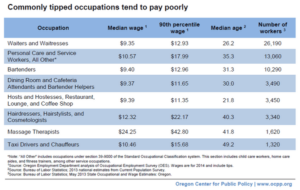Oregon workers who earn tips are, by and large, poorly paid adults. For example, the typical waiter or waitress in Oregon is about 26 years old[1] and, including tips, made about $9.35 per hour last year[2] — only 25 cents more per hour than the 2014 minimum wage.
This paper debunks the claims by the Oregon Restaurant & Lodging Association (ORLA), the lobby for restaurants and bars, that most minimum wage workers in Oregon are either (a) tipped employees making and reporting over $20 an hour in combined income, or (b) minors who live with their parents and are gaining much-needed work experience.[3] Neither statement, repeated by ORLA at a recent legislative hearing[4], is supported by the facts.
Leisure and hospitality: the biggest employer of workers earning less than $10 an hour
Oregon Employment Department wage records include wages earned in tips. That data shows that the leisure and hospitality industry — the biggest component of which is restaurants and bars — is the lowest paying industry in Oregon.
In 2014, the typical (median) wage in the leisure and hospitality industry was $10.48 — roughly half the $20 per hour claimed by the ORLA.[5] Leisure and hospitality also had the largest number of jobs that paid under $10 per hour.[6]
Tipped occupations tend to pay low wages, tips included
Federal law defines a “tipped employee” as “any employee engaged in an occupation in which he customarily and regularly receives more than $30 a month in tips.”[7] There is no official list of occupations deemed to be “tipped occupations,” so data must be gleaned from occupations known to have tipped workers.
Restaurants, including those represented by the ORLA, are the employers of the prototypical tipped occupations: people waiting tables, bartenders, dining room attendants, and hosts and hostesses. Those are low wage jobs. For example, including tips, the median or typical wage for waiters and waitresses in Oregon was $9.35 in 2014.[8] Thus, the typical waiter or waitress earned only 25 cents per hour more than the 2014 minimum wage of $9.10.
Besides the median wage, another way to measure the level of pay of an occupation is to look at the wage of someone who makes more than 90 percent of everyone in that occupation, called the 90th percentile wage. In 2014, the 90th percentile wage for Oregon waiters, waitresses, bartenders, dining room attendants, and hosts and hostesses ranged from $11.35 per hour to $12.93 per hour. Thus, they earned nowhere near the $20 per hour claimed by the ORLA.

Vast majority of workers making minimum wage are adults
Contrary to ORLA’s claim, the vast majority of workers making the minimum wage in Oregon are adults. More than eight out of 10 (86.6 percent) workers who currently earn the minimum wage or close to it are aged 20 years or older.[9]
As noted in the table above, within tipped occupations, the typical worker is an adult. For example, the median age for a waiter or waitress is 26 years. Bartenders must be adults, of course, and their median age is 31.[10]
Only a small fraction of workers earning the minimum wage could possibly be “minors who live with their parents.” The share of minimum wage workers who are minors living with parents would be even smaller under a higher minimum wage. Should lawmakers raise the minimum wage to $15 per hour by 2018 as has been proposed,[11] more than nine out of 10 (about 93 percent) minimum wage workers will be aged 20 years or older.[12]
Conclusion
The Oregon Restaurant & Lodging Association’s claim that a majority of minimum wage workers earn over $20 per hour including tips or are minors living with parents, is not supported by the data. Employment data shows that, by and large, Oregon workers who earn tips are poorly paid adults.
[1] Bureau of Labor Statistics, Employed persons by detailed occupation and age, 2013 annual averages.
[2] Oregon Employment Department analysis of Occupational Employment Survey (OES). The Oregon Employment Department methodology states, “Wages for the OES survey are straight-time gross pay excluding premium pay and nonwage fringe benefits. Some inclusions are the base pay rate, tips, commissions, and certain types of production bonuses. Some exclusions are overtime pay, housing allowances, and nonproduction bonuses.”
[3] Oregon Restaurant & Lodging Association, “ORLA Advocacy Update, Key Legislative Issues To Affect Hospitality Industry Employers,” Main Ingredient, January/February 2015, page 9, also available online.
[4] Testimony from Bill Perry, Oregon Restaurant & Lodging Association, to Oregon Senate Workforce Committee, April 13, 2015.
[5] Oregon Employment Department, Second Quarter 2014: New Highs in Jobs and Total Wages, January 2015.
[6] Oregon Employment Department, Quarterly Wage File Reports.
[7] The Fair Labor Standards Act of 1938, as amended, 29 U.S.C. 201, et seq., § 203(t).
[8] Oregon Employment Department analysis of Occupational Employment Survey (OES). The Oregon Employment Department methodology states, “Wages for the OES survey are straight-time gross pay excluding premium pay and nonwage fringe benefits. Some inclusions are the base pay rate, tips, commissions, and certain types of production bonuses. Some exclusions are overtime pay, housing allowances, and nonproduction bonuses.”
[9] Economic Policy Institute analysis of Current Population Survey, Outgoing Rotation Group public use microdata, 2013Q4-2014Q3.
[10] Bureau of Labor Statistics, Employed persons by detailed occupation and age, 2013 annual averages.
[11] HB 2009 and SB 610 (2015).
[12] Economic Policy Institute analysis of Current Population Survey, Outgoing Rotation Group public use microdata, 2013Q4-2014Q3.








